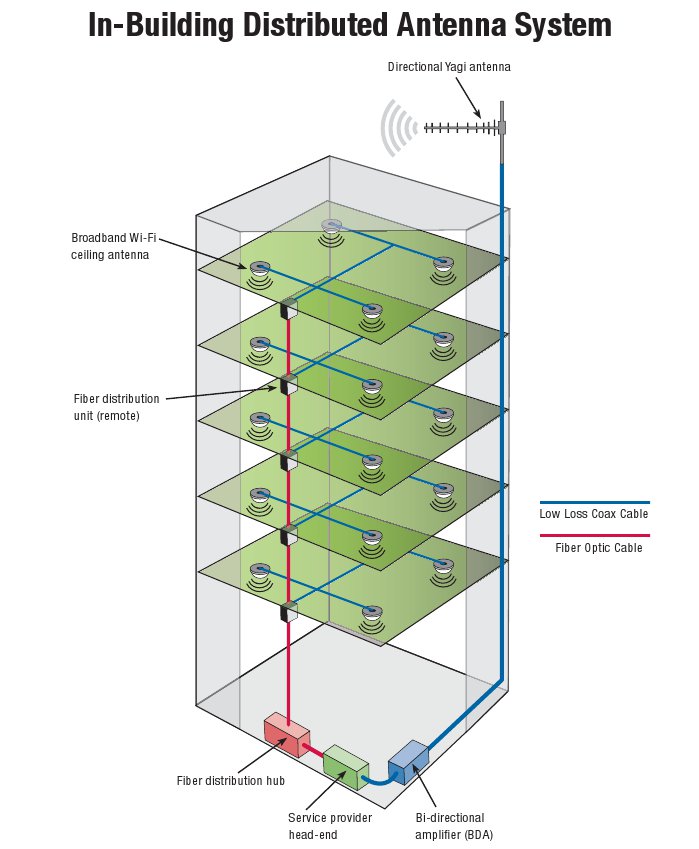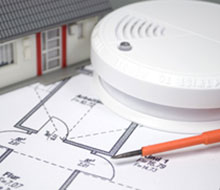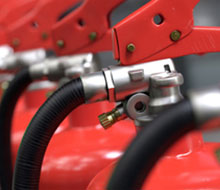Distributed Antenna Systems Explained
Have you ever walked into a building and noticed you have “no bars” on your cell phone? Radio frequency (both radio and cellular) signals are greatly reduced when passed through dense building materials such as concrete and metal. Since 2009, the International Code Council and the National Fire Protection Association have added first responder radio coverage requirements to their book of fire codes. Many states and municipalities have begun enforcing these codes. A BDA (Bi-Directional Amplifier) system is an in-building communication system that brings wireless signals into a structure from outside, amplifies those signals with a signal booster, and then evenly distributes the amplified signals throughout a structure via a Distributed Antenna System (DAS).
More specifically, A Distributed Antenna System (DAS), is a network of smaller, spatially separated antenna nodes connected to the communications network. A DAS network splits the transmitted signal among several smaller antennas to provide coverage and reliability over the same area as a single cell tower antenna. DAS networks are effective in areas with difficult topography, structural impediments (e.g. buildings, or within buildings), or in locations where, for a variety of reasons, it is not optimal to build a traditional macro sites. Many buildings are unable to receive cell phone and emergency radio signals throughout their facilities. The National Fire Code has urged jurisdictions to create guidelines requiring distributed antenna systems in larger buildings so that emergency responders are able to use their radios to communicate during emergency situations. These systems allow radio signals to be received deep in the recesses of the largest and most complex facilities, and also ensure that cell phone signals are accessible for your employees, customers, and business operations.

Design, Installation & Testing
Whether you need a system for a new building or you’re retrofitting an existing building, or a national rolllout, Global Fire Technologies has the expertise to create the optimal wireless DAS system to fit your needs. We understand the technology, the needs of those who use it, and the complexities of regulations governing first-responder communications. For more information and to speak with a Global Fire representative, please contact us today.
Fire Prevention Requirements
REQUIREMENT #105 (As stated by the Fire Prevention Requirements and Public Safety Bureau)
Two Way Radio Communications Enhancement Systems
Bi-Directional Amplifier System (BOA) Testing
All testing procedures are performed in accordance with applicable portions of the 2013 California Fire Code Section / 2014 Los Angeles City Fire Code section 51 O (Emergency Responder Radio Coverage) and NFPA 72 2013 edition Chapter 24 section 24.5.2
Two way Radio Communications Enhancement Systems
GENERAL
Applicability – Section 510·.1 of the 2013 California Fire Code/ 2014 Los Angeles City Fire Code shall be interpreted to mean any portion of a new building constructed where radio coverage signal strength levels are not consistent with Section 510.4.1 of the 2013 California Fire Code/ 2014 Los Angeles City Fire Code and meets any one of the following conditions:
- There are more than 3-stories above grade plane
- The total building area is 50,000 square feet or more
- The total basement or parking area is 10,000 square feet or more
- Any basement or level that extends 2 or more stories below grade plane
- Any building that is 20,000 square feet or greater and is equipped with a solar voltaic system
Section 510.2 of the 2013 California Fire Code / 2014 Los Angeles City Fire Code shall be Interpreted to mean any existing building that undergoes modification, to the extent that the building’s fire alarm system must be replaced, or upgraded and re-certified and meets any one of the conditions listed above for new buildings under Section 510.1 of the 2013 California Fire Code/ 2014 Los Angeles City Fire Code.




